This...is a story of failure. Of repeated failure. Of failure and the disappointment of many young friends, specifically including Orville, Wilbur, and Zuko, none of whom will appear in today's post because I didn't get to a finished product while they were around to try it, plus it was too challenging to take action eating shots in blacklight with a point-and-shoot. However, we did eventually succeed in making fluorescent Jello, so I figured I'd post all the failed attempts and show you the end product that only Sparky and I got to enjoy.
To start out, I should again mention that we are blessed (as I've said many a time before) to live in a culturally rich area where we can try all kinds of interesting and exciting things - not the least of which are Asian jelly desserts. One of our favorite local Japanese restaurants is famous for its orange gelatin (made with orange juice and pears, often molded in a hollowed-out orange that's cut into slices - so your jello has a peel) and another favorite is a mango gelatin goldfish that's served as a holiday dessert in Chicago's Chinatown. Both these delicious treats are made with Agar-agar, a type of seaweed, which in my opinion has a superior texture than our more common gelatin. (It's also vegetarian - regular gelatin is not.)
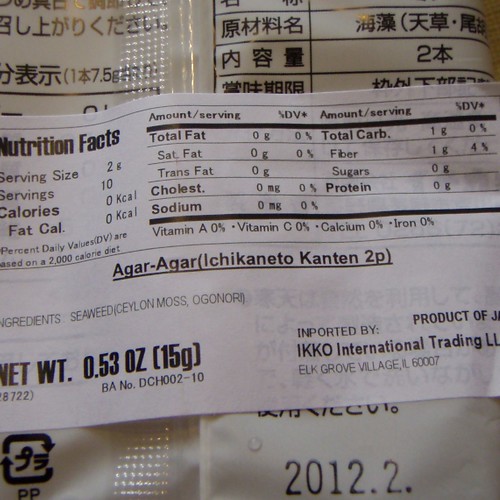 When we made a recent visit to our local Mitsuwa Marketplace, I was excited to find Kanten sticks - the Japanese version of Agar-agar, so I thought I would put it to good use in our first attempt at Glow In The Dark Gelatin. Unfortunately, like many things in Asian markets, the directions were in Japanese, so I had to piece together how to make Agar from the Internet. I only partially succeeded, (apparently kanten is especially susceptible to acidic ingredients) but here's what we did:
When we made a recent visit to our local Mitsuwa Marketplace, I was excited to find Kanten sticks - the Japanese version of Agar-agar, so I thought I would put it to good use in our first attempt at Glow In The Dark Gelatin. Unfortunately, like many things in Asian markets, the directions were in Japanese, so I had to piece together how to make Agar from the Internet. I only partially succeeded, (apparently kanten is especially susceptible to acidic ingredients) but here's what we did: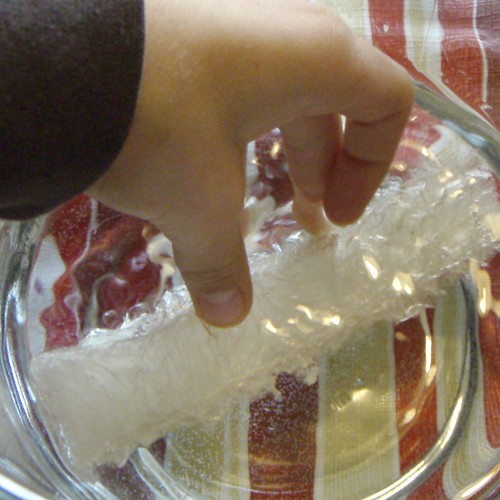 Sparky cut one of the sticks in half (they're very cool, kind of like layered cellophane) and we soaked it in water for an hour. After the soak, he squeezed out the excess water and tore the kanten into chunks,
Sparky cut one of the sticks in half (they're very cool, kind of like layered cellophane) and we soaked it in water for an hour. After the soak, he squeezed out the excess water and tore the kanten into chunks,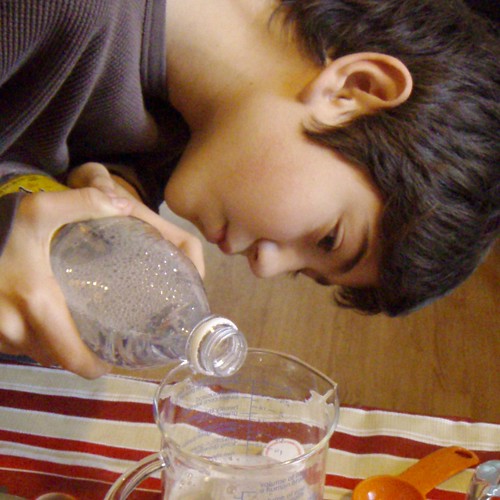 which we dumped into a pot with a cup of tonic water and a good squirt of pasteurized lime juice (yes, grownups, add gin by all means.) This was heated until the kanten dissolved completely, and then poured into a mold. (At around this time, Wilbur and Orville had to leave.) I then had the brilliant idea of adding clementine slices, which may have been the final blow to my kanten's holding power...because after spending the night in the refrigerator, we came out with something remarkably close to the texture of...snot. A giant heaping pile of it. It did, indeed set up - but not enough to mold. Someday, we'll be trying to make kanten again...but not with tonic water.
which we dumped into a pot with a cup of tonic water and a good squirt of pasteurized lime juice (yes, grownups, add gin by all means.) This was heated until the kanten dissolved completely, and then poured into a mold. (At around this time, Wilbur and Orville had to leave.) I then had the brilliant idea of adding clementine slices, which may have been the final blow to my kanten's holding power...because after spending the night in the refrigerator, we came out with something remarkably close to the texture of...snot. A giant heaping pile of it. It did, indeed set up - but not enough to mold. Someday, we'll be trying to make kanten again...but not with tonic water.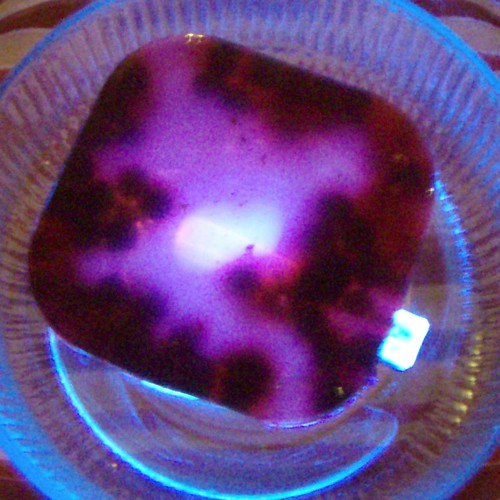 So on to take two, this time with regular plain gelatin (1 packet of Knox gelatin to 2 cups of tonic water/lime juice, following the directions on the box,) and I just couldn't help myself and added berries from the freezer for a tastier treat. To Zuko's great chagrin, we wound up with slightly bitter gelatin....that didn't glow in a blacklight.
So on to take two, this time with regular plain gelatin (1 packet of Knox gelatin to 2 cups of tonic water/lime juice, following the directions on the box,) and I just couldn't help myself and added berries from the freezer for a tastier treat. To Zuko's great chagrin, we wound up with slightly bitter gelatin....that didn't glow in a blacklight.Finally, I just chucked the whole idea and did it myself, following the directions on the box -2 packets of gelatin, 4 cups of tonic water and a couple tablespoons of sugar (I didn't bother with the lime) and then unmolded the whole thing onto a glass tray set over a battery-powered blacklight. Cool, huh? It is rather bitter, although there's quite a bit of sugar in tonic water to begin with - Sparky didn't mind it - heck, it glowed like an alien life force, so it didn't have to taste good!
At any rate, the science behind glowing gelatin is this: tonic water contains a bittering agent known as quinine, which is extracted from the bark of a tree (Remijia.) Quinine is a phosphor, a substance which converts radiation (the ultraviolet radiation from a blacklight, for instance,) into visible light. As long as you've got a blacklight and sufficient darkness, you can also make a glowing Mentos/Tonic water fountain (use diet, it's less sticky,) and flavor your drinks with glowing ice cubes...
(Tonic water on the left, regular tap water on the right.)

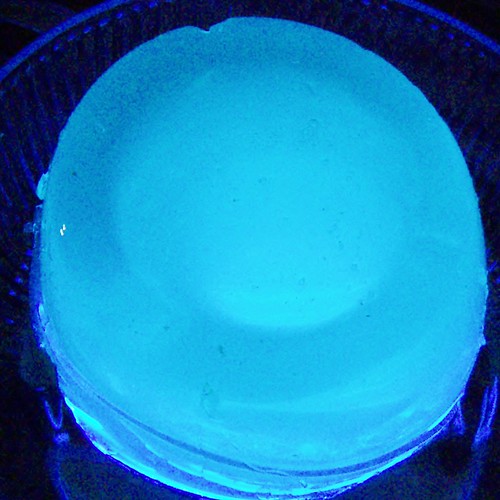
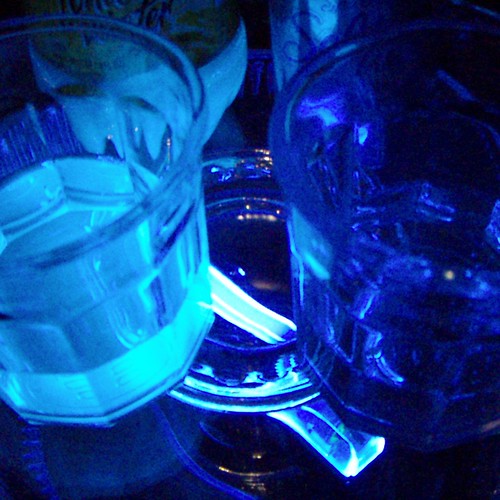




No comments:
Post a Comment